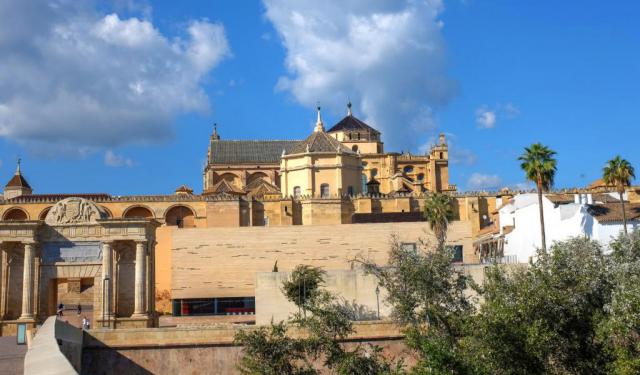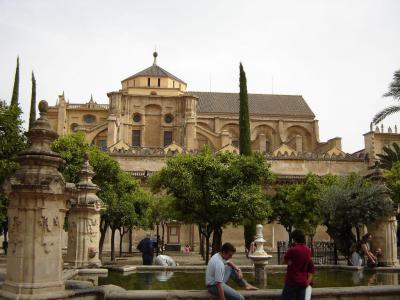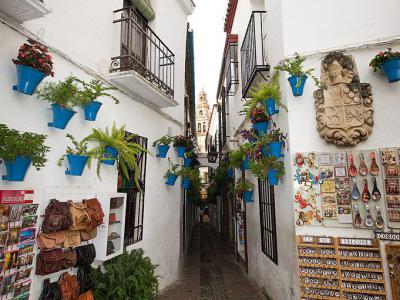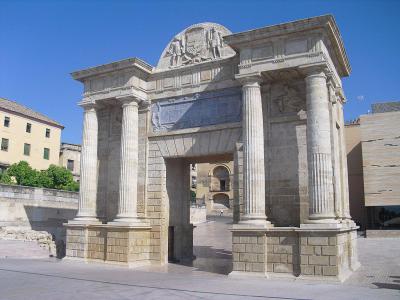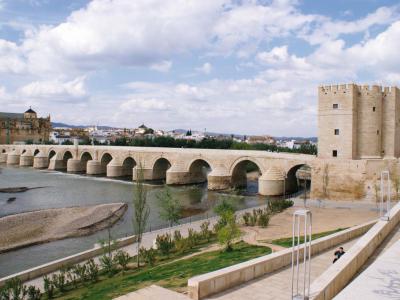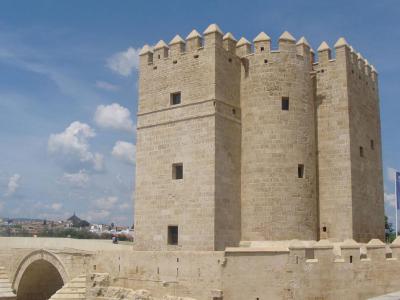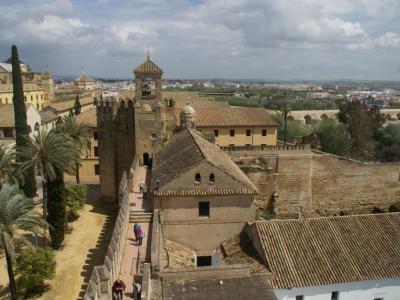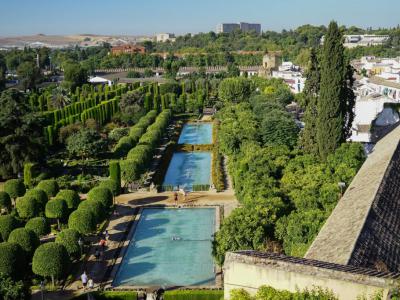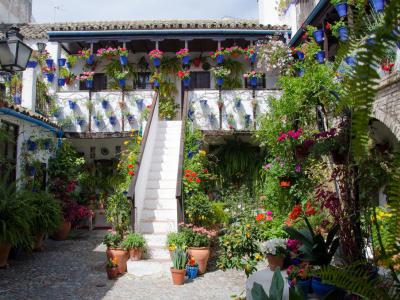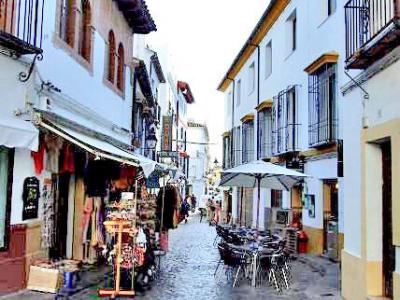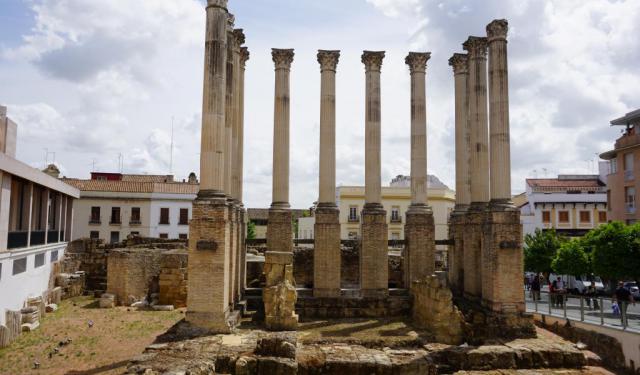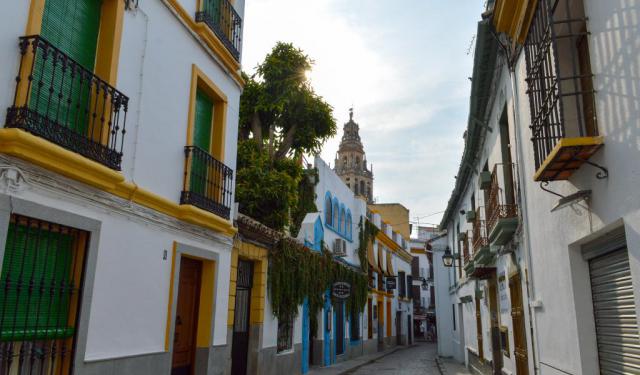Audio Guide: Cordoba Introduction Walking Tour (Self Guided), Cordoba
Córdoba treats history like a sculptor treats marble-layered, chiseled, and ever revealing something new. Situated in Andalusia, this city has seen empires rise, and its story spans over 2,200 years. Originally named Qart Juba by the Carthaginians, it was refounded in 206 BC by the Romans as Corduba. As the capital of the province Hispania Ulterior, it had to prove its reputation by having its territory lined by temples, forums and imposing city walls.
Then, in 711 AD, Córdoba flipped the script and entered its most dazzling chapter. As the capital of Muslim-ruled Iberia, it was by the 10th century rubbing shoulders with Constantinople as one of Europe’s largest and most glamorous cities. Streets were paved and lit after dark, aqueducts delivered fresh water, and the markets smelled like silk, saffron, and ambition. More than 80 libraries-one of them crammed with over 400,000 volumes-turned the city into an irresistible magnet for scholars.
Here, medicine, astronomy, philosophy, and mathematics weren’t just taught-they were reimagined. Translators rescued Aristotle, Galen, and Ptolemy from the dusty shelves of history, making sure their ideas survived to inspire medieval Europe. And Caliph Abd al-Rahman III? He built Madinat al-Zahra, a glittering statement piece that doubled as both royal home and political theatre.
Things got rocky in the 11th century with civil wars and the caliphate’s collapse, but Córdoba’s cultural pulse never flatlined. Muslims, Christians, and Jews each added their own brushstrokes to the canvas-sometimes as collaborators, sometimes as competitors. When Christian forces took the city in 1236, Gothic churches rose next to Islamic arches, and the city’s architecture began an ongoing conversation between past and present.
That conversation is still happening. You can hear it in the columns of the Mosque-Cathedral, in the hushed grace of the medieval synagogue, and in the maze-like streets of the Old Town. Now a UNESCO World Heritage Site and Spain’s largest historic centre, Córdoba wears its history like a layered robe-every fold tells a story.
Every turn of a corner offers another page to read: a courtyard that smells of orange blossom, a plaza echoing with guitar strings, or a centuries-old wall catching the late afternoon light. Córdoba keeps the conversation alive, letting each visitor add their own footsteps to the story.
Then, in 711 AD, Córdoba flipped the script and entered its most dazzling chapter. As the capital of Muslim-ruled Iberia, it was by the 10th century rubbing shoulders with Constantinople as one of Europe’s largest and most glamorous cities. Streets were paved and lit after dark, aqueducts delivered fresh water, and the markets smelled like silk, saffron, and ambition. More than 80 libraries-one of them crammed with over 400,000 volumes-turned the city into an irresistible magnet for scholars.
Here, medicine, astronomy, philosophy, and mathematics weren’t just taught-they were reimagined. Translators rescued Aristotle, Galen, and Ptolemy from the dusty shelves of history, making sure their ideas survived to inspire medieval Europe. And Caliph Abd al-Rahman III? He built Madinat al-Zahra, a glittering statement piece that doubled as both royal home and political theatre.
Things got rocky in the 11th century with civil wars and the caliphate’s collapse, but Córdoba’s cultural pulse never flatlined. Muslims, Christians, and Jews each added their own brushstrokes to the canvas-sometimes as collaborators, sometimes as competitors. When Christian forces took the city in 1236, Gothic churches rose next to Islamic arches, and the city’s architecture began an ongoing conversation between past and present.
That conversation is still happening. You can hear it in the columns of the Mosque-Cathedral, in the hushed grace of the medieval synagogue, and in the maze-like streets of the Old Town. Now a UNESCO World Heritage Site and Spain’s largest historic centre, Córdoba wears its history like a layered robe-every fold tells a story.
Every turn of a corner offers another page to read: a courtyard that smells of orange blossom, a plaza echoing with guitar strings, or a centuries-old wall catching the late afternoon light. Córdoba keeps the conversation alive, letting each visitor add their own footsteps to the story.
How it works: Download the app "GPSmyCity: Walks in 1K+ Cities" from Apple App Store or Google Play Store to your mobile phone or tablet. The app turns your mobile device into a personal tour guide and its built-in GPS navigation functions guide you from one tour stop to next. The app works offline, so no data plan is needed when traveling abroad.
Cordoba Introduction Walking Tour Map
Guide Name: Cordoba Introduction Walking Tour
Guide Location: Spain » Cordoba (See other walking tours in Cordoba)
Guide Type: Self-guided Walking Tour (Sightseeing)
# of Attractions: 9
Tour Duration: 2 Hour(s)
Travel Distance: 3.3 Km or 2.1 Miles
Author: DanaOffice
Sight(s) Featured in This Guide:
Guide Location: Spain » Cordoba (See other walking tours in Cordoba)
Guide Type: Self-guided Walking Tour (Sightseeing)
# of Attractions: 9
Tour Duration: 2 Hour(s)
Travel Distance: 3.3 Km or 2.1 Miles
Author: DanaOffice
Sight(s) Featured in This Guide:
- Mezquita Catedral de Cordoba (Mosque-Cathedral of Cordoba)
- Calleja de las Flores (Alley of the Flowers)
- Puerta del Puente (Gate of the Bridge)
- Puente Romano de Cordoba (Roman Bridge of Cordoba)
- Torre De Calahorra (Calahorra Tower)
- Alcazar de los Reyes Cristianos (Castle of the Christian Monarchs)
- Jardines del Alcázar (The Gardens of the Alcazar)
- Patios de Cordoba (Cordoba Cortyards) and San Basilio Patio 44
- Calle de los Judios (Jewish Street in Jewish Quarter)
1) Mezquita Catedral de Cordoba (Mosque-Cathedral of Cordoba) (must see)
Back in 755, Abd al-Rahman I had one priority: staying alive. The last prince of the Umayyad dynasty, he was on the run from the Abbasids, who had toppled his family in Syria with a finality that left little room for second chances. He crossed into Iberia with more nerve than backup-and found just enough political tension among the local Muslim rulers to make a comeback. By 785, he wasn’t just surviving. He was laying the foundations of the Great Mosque of Córdoba.
What started as one man’s foothold became, over the next two centuries, the largest mosque in the Islamic world. At its peak in the 10th century, the complex covered a footprint rivaling Saint Peter’s in Rome-though the style couldn’t have been more different. No domes-on-domes here. Instead, the mosque stretched out low and wide, echoing the vast courtyards of desert prayer grounds. A third of the space is open air-now the Courtyard of the Orange Trees, once used for ritual ablutions. Nearby, the Gate of Forgiveness still leads toward the massive bell tower, which began life as a 10th-century minaret.
Inside, it’s a grid of visual rhythm-856 columns of jasper, onyx, marble, and granite supporting a ceiling painted in gold and rich geometric designs. Furthermore, the famous red-and-white arches are not just decorative-they hold the roof up while holding your gaze. The prayer hall remains one of the most atmospheric interiors in Europe, with light shifting across shadowy stone like a silent procession.
Then came the Reconquest in 1236, and with it, King Ferdinand III. Córdoba changed hands, and so did the mosque. Chapels were added. The first was the Villaviciosa Chapel. Later on, Renaissance builders dropped a full cathedral right into the middle of the mosque’s open hall-arches and all. They didn’t hold back, adding a cross-shaped layout, a grand central chapel, and side wings. The result? A style mix that sounds like it should clash, but doesn’t: bits of Gothic height, Baroque flair, elegant Renaissance shapes, and the delicate touch of the original Islamic design still visible beneath it all.
There’s even an elliptical dome adorned with prophets and evangelists, just in case the architectural layering wasn’t obvious enough. Today, the Mosque-Cathedral of Córdoba is a UNESCO World Heritage Site and a headline act in Spain’s architectural repertoire-part sanctuary, part time capsule, and entirely unforgettable.
What started as one man’s foothold became, over the next two centuries, the largest mosque in the Islamic world. At its peak in the 10th century, the complex covered a footprint rivaling Saint Peter’s in Rome-though the style couldn’t have been more different. No domes-on-domes here. Instead, the mosque stretched out low and wide, echoing the vast courtyards of desert prayer grounds. A third of the space is open air-now the Courtyard of the Orange Trees, once used for ritual ablutions. Nearby, the Gate of Forgiveness still leads toward the massive bell tower, which began life as a 10th-century minaret.
Inside, it’s a grid of visual rhythm-856 columns of jasper, onyx, marble, and granite supporting a ceiling painted in gold and rich geometric designs. Furthermore, the famous red-and-white arches are not just decorative-they hold the roof up while holding your gaze. The prayer hall remains one of the most atmospheric interiors in Europe, with light shifting across shadowy stone like a silent procession.
Then came the Reconquest in 1236, and with it, King Ferdinand III. Córdoba changed hands, and so did the mosque. Chapels were added. The first was the Villaviciosa Chapel. Later on, Renaissance builders dropped a full cathedral right into the middle of the mosque’s open hall-arches and all. They didn’t hold back, adding a cross-shaped layout, a grand central chapel, and side wings. The result? A style mix that sounds like it should clash, but doesn’t: bits of Gothic height, Baroque flair, elegant Renaissance shapes, and the delicate touch of the original Islamic design still visible beneath it all.
There’s even an elliptical dome adorned with prophets and evangelists, just in case the architectural layering wasn’t obvious enough. Today, the Mosque-Cathedral of Córdoba is a UNESCO World Heritage Site and a headline act in Spain’s architectural repertoire-part sanctuary, part time capsule, and entirely unforgettable.
2) Calleja de las Flores (Alley of the Flowers)
Just off the main artery of Córdoba’s historic centre-close enough to the Mosque-Cathedral to hear its bells stretch-there’s a street with a long name and a short introduction. It’s called Ricardo Velázquez Bosco, and if you spot a fading Arabesque carving near the curb, congratulations: you’ve found the entrance to the Alley of the Flowers. This narrow, cobbled alleyway is famous for its picturesque beauty, with whitewashed walls adorned with vibrant flower pots overflowing with seasonal blooms.
Walls on both sides are whitewashed so bright they could double as light reflectors, and every window grid competes in a silent showdown of vines, reds, and ivy-green. The path snakes to a tiny courtyard, where the Mosque-Cathedral’s bell tower politely photobombs every frame. There’s a fountain tucked in a corner, modest in size but serious in pedigree-its column once belonged to a Roman structure, now still trickling away as it has for decades.
Architect Victor Ucelay gave the whole scene a tune-up in the 20th century. He swapped in local river stones for paving, threw in some granite slabs for good measure, and arched a few doorways to complete the look. The red geraniums and green pots weren’t part of the instructions, but the neighborhood made sure they showed up anyway.
Come early May, when Córdoba’s flowers are busy taking over the city, this narrow alley hums with restraint. Birds handle the melody, the Cathedral chimes in occasionally, and the fountain-always on time-keeps rhythm in the square.
Walls on both sides are whitewashed so bright they could double as light reflectors, and every window grid competes in a silent showdown of vines, reds, and ivy-green. The path snakes to a tiny courtyard, where the Mosque-Cathedral’s bell tower politely photobombs every frame. There’s a fountain tucked in a corner, modest in size but serious in pedigree-its column once belonged to a Roman structure, now still trickling away as it has for decades.
Architect Victor Ucelay gave the whole scene a tune-up in the 20th century. He swapped in local river stones for paving, threw in some granite slabs for good measure, and arched a few doorways to complete the look. The red geraniums and green pots weren’t part of the instructions, but the neighborhood made sure they showed up anyway.
Come early May, when Córdoba’s flowers are busy taking over the city, this narrow alley hums with restraint. Birds handle the melody, the Cathedral chimes in occasionally, and the fountain-always on time-keeps rhythm in the square.
3) Puerta del Puente (Gate of the Bridge)
The Gate of the Bridge has been standing guard since the days of Julius Caesar, back when traffic on the Roman road Augusta way meant chariots, not tour buses. It marked the main entrance into Córdoba and linked up with the Roman Bridge, forming part of what was essentially the city’s ancient welcome mat. Rumor has it a statue of Venus once topped the gate-using her status as goddess of love to attract city visitors. She didn’t make it past the Moorish period, though-wrong pantheon.
Under Islamic rule, the gate picked up a handful of different names, depending on who you asked. Some called it Bab al-Qantara, meaning the Gate of the Bridge. Others went with Bab al-Wadi, the Gate of the River, or Bab al-Yazir, the Gate of Algeciras. When Christian forces reclaimed Córdoba during the Reconquest, they decided to keep the Algeciras name-because why mess with a label that already worked? By the late 1500s, Mayor Ortega figured the old gate needed a royal upgrade before King Felipe II showed up. Architect Montalbán began the makeover, and Ruiz the Younger wrapped it up in 1576.
Hopping to 1912-King Alfonso XIII is on the throne, and the gate has had enough of being boxed in by neighbors. The surrounding buildings were cleared, and by 1928, it had evolved into the solo monument you see today, standing like a proud relic that just got its own spotlight.
Nowadays, the gate is more than just a photo op. You can actually go inside. There’s a small exhibition room with illustrations of its past lives, and if you climb to the top, the balcony offers a sweeping view of the square, the bridge, and the slow march of time.
Under Islamic rule, the gate picked up a handful of different names, depending on who you asked. Some called it Bab al-Qantara, meaning the Gate of the Bridge. Others went with Bab al-Wadi, the Gate of the River, or Bab al-Yazir, the Gate of Algeciras. When Christian forces reclaimed Córdoba during the Reconquest, they decided to keep the Algeciras name-because why mess with a label that already worked? By the late 1500s, Mayor Ortega figured the old gate needed a royal upgrade before King Felipe II showed up. Architect Montalbán began the makeover, and Ruiz the Younger wrapped it up in 1576.
Hopping to 1912-King Alfonso XIII is on the throne, and the gate has had enough of being boxed in by neighbors. The surrounding buildings were cleared, and by 1928, it had evolved into the solo monument you see today, standing like a proud relic that just got its own spotlight.
Nowadays, the gate is more than just a photo op. You can actually go inside. There’s a small exhibition room with illustrations of its past lives, and if you climb to the top, the balcony offers a sweeping view of the square, the bridge, and the slow march of time.
4) Puente Romano de Cordoba (Roman Bridge of Cordoba) (must see)
Stretching across the Guadalquivir River with quiet confidence is Cordoba’s Roman Bridge-less “majestic” and more “still standing after two millennia.” On one end, the Mosque-Cathedral anchors the view; on the other, the Calahorra Tower keeps watch. Back in the 12th century, Arab cartographer Muhammad al-Idrisi wasn’t shy with praise-he called it the best-looking, sturdiest bridge around.
Originally built in the 1st century BC, it carried the mighty Augusta way, the Roman highway that once stitched together Rome and Cádiz. In the early 700s, the bridge had a full makeover-sixteen arches, 800-plus feet long, wide enough for carts, soldiers, and the occasional goat.
Let's skip forward to the medieval times: the Calahorra Tower was added on one side, and the Gate of the Bridge on the other. A statue of Saint Raphael landed center stage in the 17th century. Over the years, repairs came and went-today, only two arches on the north end remain truly Roman. The rest? Roman-adjacent.
In 2006, a major restoration stirred the pot. Architect Juan Montilla gave the bridge a polish-pink granite paving, minimalist lighting, and a tidy-up of the starling-shaped breakwaters. Even the saints’ niches got spruced up. The north end was lifted slightly to meet the riverside promenade-practical, if not purist.
Now protected as a cultural monument since 1931, the bridge, gate, and tower joined UNESCO’s World Heritage list in 1984. Oh, and for fantasy fans: the Roman Bridge served as the Long Bridge of Volantis in Game of Thrones. Try not to imagine dragons.
Originally built in the 1st century BC, it carried the mighty Augusta way, the Roman highway that once stitched together Rome and Cádiz. In the early 700s, the bridge had a full makeover-sixteen arches, 800-plus feet long, wide enough for carts, soldiers, and the occasional goat.
Let's skip forward to the medieval times: the Calahorra Tower was added on one side, and the Gate of the Bridge on the other. A statue of Saint Raphael landed center stage in the 17th century. Over the years, repairs came and went-today, only two arches on the north end remain truly Roman. The rest? Roman-adjacent.
In 2006, a major restoration stirred the pot. Architect Juan Montilla gave the bridge a polish-pink granite paving, minimalist lighting, and a tidy-up of the starling-shaped breakwaters. Even the saints’ niches got spruced up. The north end was lifted slightly to meet the riverside promenade-practical, if not purist.
Now protected as a cultural monument since 1931, the bridge, gate, and tower joined UNESCO’s World Heritage list in 1984. Oh, and for fantasy fans: the Roman Bridge served as the Long Bridge of Volantis in Game of Thrones. Try not to imagine dragons.
5) Torre De Calahorra (Calahorra Tower)
At the southern tip of the Roman Bridge, standing guard like it never got the memo the war ended, is the Calahorra Tower-Cordoba’s original “no entry” sign. Built in the 12th century when Muslims were still in charge , this chunky gatehouse wasn’t here for decoration-it was here to keep trouble off the bridge and out of the city.
Originally, it was just two square towers connected by an arch. Then things got dramatic. In 1369, King Enrique III of Castile gave it a full medieval upgrade-fortified it, bulked it up, and added a third, round tower in the middle. You might wonder why. Well, he wasn’t a fan of being overthrown by his famously villainous brother, Pedro the Cruel. Family reunions were tense back then.
Inside, you’ll find eight rooms now home to the Al-Andalus Living Museum. It’s not your average museum: think immersive audio-visuals, not dusty glass cases. The exhibits recreate Cordoba’s golden age-when scholars, artists, and thinkers from Islam, Christianity, and Judaism shared ideas (and sometimes dinner) from the 9th to the 13th century.
And if history doesn’t do it for you, the rooftop might. The pierced terrace delivers wide-angle views of the Mosque-Cathedral and the entire Old City-minus the medieval siege engines, thankfully.
Originally, it was just two square towers connected by an arch. Then things got dramatic. In 1369, King Enrique III of Castile gave it a full medieval upgrade-fortified it, bulked it up, and added a third, round tower in the middle. You might wonder why. Well, he wasn’t a fan of being overthrown by his famously villainous brother, Pedro the Cruel. Family reunions were tense back then.
Inside, you’ll find eight rooms now home to the Al-Andalus Living Museum. It’s not your average museum: think immersive audio-visuals, not dusty glass cases. The exhibits recreate Cordoba’s golden age-when scholars, artists, and thinkers from Islam, Christianity, and Judaism shared ideas (and sometimes dinner) from the 9th to the 13th century.
And if history doesn’t do it for you, the rooftop might. The pierced terrace delivers wide-angle views of the Mosque-Cathedral and the entire Old City-minus the medieval siege engines, thankfully.
6) Alcazar de los Reyes Cristianos (Castle of the Christian Monarchs) (must see)
Long before it became the Castle of the Christian Monarchs, this patch of Córdoba was guarded by a Visigothic fortress. In the late 8th century, Abd ar-Rahman I decided the city deserved something grander-so up went a fortified palace with baths, gardens, and a library that could humble most of Europe. The Almohads, a Berber dynasty with a taste for expansion, kept the upgrades coming in the 12th and 13th centuries.
Everything changed in 1236, when Christian forces claimed Córdoba. Alfonso XI rebuilt the castle in the Mudejar style, mixing Islamic elegance with Gothic muscle. By the time gunpowder made its noisy debut in European warfare, the fortress had its walls beefed up for cannon fire.
It wasn’t all flowers and fountains. In the late 15th century, Isabella I of Castile and Ferdinand II of Aragon moved in and turned the place into headquarters for the Spanish Inquisition. Christopher Columbus came here in 1486 to pitch his “let’s sail west” idea, while the Inquisition turned the Arab Baths into interrogation rooms. Napoleon’s troops bunked here in 1810; by 1821, it was a prison.
Four towers guard its corners like mismatched sentinels: the octagonal Tower of Homage with its graceful ogival ceiling; the Tower of Lions, watched over by stone gargoyles; the circular Tower of the Inquisition, as ominous as it sounds; and the Tower of the Dove, a 19th-century stand-in for the one that didn’t survive.
Inside, the Hall of the Mosaics lines its walls with Roman artistry, while the Courtyard of the Moriscos pairs arched verandas with a central fountain and twin ponds. The Royal Baths of Doña Leonor-built in 1328 for Alfonso XI’s mistress-add another layer to the palace’s tangled past, and the Courtyard of the Women recalls its years as a women’s prison.
Since 1931, the Alcázar has held Cultural Interest Heritage status, and in 1994 it joined Córdoba’s UNESCO-listed Historic Centre. Between its fortified towers, manicured gardens, and centuries of political intrigue, it’s less a single monument than an entire chapter of Spanish history bound in stone.
Everything changed in 1236, when Christian forces claimed Córdoba. Alfonso XI rebuilt the castle in the Mudejar style, mixing Islamic elegance with Gothic muscle. By the time gunpowder made its noisy debut in European warfare, the fortress had its walls beefed up for cannon fire.
It wasn’t all flowers and fountains. In the late 15th century, Isabella I of Castile and Ferdinand II of Aragon moved in and turned the place into headquarters for the Spanish Inquisition. Christopher Columbus came here in 1486 to pitch his “let’s sail west” idea, while the Inquisition turned the Arab Baths into interrogation rooms. Napoleon’s troops bunked here in 1810; by 1821, it was a prison.
Four towers guard its corners like mismatched sentinels: the octagonal Tower of Homage with its graceful ogival ceiling; the Tower of Lions, watched over by stone gargoyles; the circular Tower of the Inquisition, as ominous as it sounds; and the Tower of the Dove, a 19th-century stand-in for the one that didn’t survive.
Inside, the Hall of the Mosaics lines its walls with Roman artistry, while the Courtyard of the Moriscos pairs arched verandas with a central fountain and twin ponds. The Royal Baths of Doña Leonor-built in 1328 for Alfonso XI’s mistress-add another layer to the palace’s tangled past, and the Courtyard of the Women recalls its years as a women’s prison.
Since 1931, the Alcázar has held Cultural Interest Heritage status, and in 1994 it joined Córdoba’s UNESCO-listed Historic Centre. Between its fortified towers, manicured gardens, and centuries of political intrigue, it’s less a single monument than an entire chapter of Spanish history bound in stone.
7) Jardines del Alcázar (The Gardens of the Alcazar)
Back in the 10th century, Abd ar-Rahman III decided Córdoba could use a touch of hydraulic flair. He built an aqueduct, installed a working noria (waterwheel), and laid out gardens and orchards that thrived under a clever irrigation system fed by the Guadalquivir River.
Moving forward to the 16th century and Queen Isabella, for reasons lost to history-perhaps the creaking annoyed her-ordered the waterwheel to stop. Without its lifeline, the gardens faded into decline. By the 20th century, what remained was little more than a ghost of its former self, until a major renovation revived the space. The new layout, trimmed by road construction, was smaller than the original, but still grand enough to make an impression.
Today, the gardens spread over 55,000 square meters of palm, cypress, orange, and lemon trees, threaded with elegant fountains and reflective ponds. They unfold across three tiers: the upper level sits beside the Tower of Lions, the middle boasts a sweeping staircase flanked by two vast pools, and the lower spreads out with three more pools, tightly clipped greenery, and the Promenade of Kings.
Here, statues of Christopher Columbus and his royal backers, Ferdinand II and Isabella, stand in stone conversation, a reminder that these grounds have seen everything from Moorish engineering to imperial ambition.
Moving forward to the 16th century and Queen Isabella, for reasons lost to history-perhaps the creaking annoyed her-ordered the waterwheel to stop. Without its lifeline, the gardens faded into decline. By the 20th century, what remained was little more than a ghost of its former self, until a major renovation revived the space. The new layout, trimmed by road construction, was smaller than the original, but still grand enough to make an impression.
Today, the gardens spread over 55,000 square meters of palm, cypress, orange, and lemon trees, threaded with elegant fountains and reflective ponds. They unfold across three tiers: the upper level sits beside the Tower of Lions, the middle boasts a sweeping staircase flanked by two vast pools, and the lower spreads out with three more pools, tightly clipped greenery, and the Promenade of Kings.
Here, statues of Christopher Columbus and his royal backers, Ferdinand II and Isabella, stand in stone conversation, a reminder that these grounds have seen everything from Moorish engineering to imperial ambition.
8) Patios de Cordoba (Cordoba Cortyards) and San Basilio Patio 44 (must see)
Córdoba’s summers have been hot and bone-dry for as long as anyone’s been keeping track-which is why the Romans, Visigoths, Muslims, and later Andalusians all agreed on one thing: survival required shade, airflow, and a dash of beauty. The solution was the patio-an inward-facing courtyard designed to let in the light while keeping out the worst of the heat. A fountain provided cool sound and cooler air, while a basin caught precious rainwater. Islamic architects refined the idea with a shaded passageway that funneled you off the street and into a green, blooming refuge.
In the Saint Basilio district, Patio 44 takes that tradition and turns it into a calling card. Dating back to the 15th century, it now houses the Friends Association of Cordoban Patios-a group dedicated to keeping the city’s courtyards both alive and in bloom.
Step through its porch and you find yourself in a two-story courtyard wrapped in balconies, where the ground floor hums with studios and shops showing off local craftsmanship. Here, ceramics, leatherwork, and other Cordoban specialties are as much part of the scenery as the flowers.
Every May since 1921, the Town Hall has made patios the star of their own celebration: the Courtyards and Crosses Festival. For a few weeks, homeowners compete-not quietly-to outdo each other in floral displays. Singing, dancing, wine, tapas, and unapologetic colour fill the air, turning the city into an open invitation to wander.
In the Saint Basilio district, Patio 44 takes that tradition and turns it into a calling card. Dating back to the 15th century, it now houses the Friends Association of Cordoban Patios-a group dedicated to keeping the city’s courtyards both alive and in bloom.
Step through its porch and you find yourself in a two-story courtyard wrapped in balconies, where the ground floor hums with studios and shops showing off local craftsmanship. Here, ceramics, leatherwork, and other Cordoban specialties are as much part of the scenery as the flowers.
Every May since 1921, the Town Hall has made patios the star of their own celebration: the Courtyards and Crosses Festival. For a few weeks, homeowners compete-not quietly-to outdo each other in floral displays. Singing, dancing, wine, tapas, and unapologetic colour fill the air, turning the city into an open invitation to wander.
9) Calle de los Judios (Jewish Street in Jewish Quarter) (must see)
The Jewish Quarter of Córdoba isn’t so much a neighbourhood as it is a time capsule with street signs. Dating back to the 10th century, it sprawls through a knot of lanes named Deanes, Manríquez, Tomás Conde, Judíos, Almanzor, and Romero. This UNESCO-listed patch of the Old City packs in some heavy hitters: the Mosque-Cathedral, the city’s sole surviving synagogue, the Zoco Municipal Market, and, in a twist only Spain could pull off, the Bullfighting Museum.
Along Jewish Street, you’ll find a bronze statue of Maimonides-the Jewish philosopher and physician whose reputation travelled farther than most armies of his day. Back when Córdoba was under Umayyad rule, roughly from the 10th to the 15th century, the city was considered the cultural capital of the Western world, a place where ideas and inventions crossed paths as easily as merchants in its markets.
The fortified Gate of Almodóvar serves as one of the quarter’s main entrances, its two towers bridged by a stone arch topped with a crown of battlements. Nearby, Maimonides Square offers a quiet pause before you plunge back into streets that are equal parts map and maze-many of them ending abruptly, as if the medieval planners just got distracted. The famous Alley of the Flowers is here too, framing postcard shots with practiced ease. Keep going, and you’ll reach the quarter’s spiritual heart: Córdoba’s synagogue, a survivor that has worn many hats over the centuries-temple, hospital, hermitage, nursery school.
Right next door, the House of Sepharad-also called the House of Memory-preserves the stories, music, and traditions of Jewish Spain in a 14th-century building. The Andalusian House showcases the city’s role in early papermaking, back when the Caliphate was churning out books faster than most of Europe could read them. And then there’s Handkerchief Alley, a sliver of a street so narrow you could block it with an outstretched scarf. At its end, as if to reward your efforts, is a tiny courtyard with a fountain murmuring away like nothing’s changed in centuries.
Along Jewish Street, you’ll find a bronze statue of Maimonides-the Jewish philosopher and physician whose reputation travelled farther than most armies of his day. Back when Córdoba was under Umayyad rule, roughly from the 10th to the 15th century, the city was considered the cultural capital of the Western world, a place where ideas and inventions crossed paths as easily as merchants in its markets.
The fortified Gate of Almodóvar serves as one of the quarter’s main entrances, its two towers bridged by a stone arch topped with a crown of battlements. Nearby, Maimonides Square offers a quiet pause before you plunge back into streets that are equal parts map and maze-many of them ending abruptly, as if the medieval planners just got distracted. The famous Alley of the Flowers is here too, framing postcard shots with practiced ease. Keep going, and you’ll reach the quarter’s spiritual heart: Córdoba’s synagogue, a survivor that has worn many hats over the centuries-temple, hospital, hermitage, nursery school.
Right next door, the House of Sepharad-also called the House of Memory-preserves the stories, music, and traditions of Jewish Spain in a 14th-century building. The Andalusian House showcases the city’s role in early papermaking, back when the Caliphate was churning out books faster than most of Europe could read them. And then there’s Handkerchief Alley, a sliver of a street so narrow you could block it with an outstretched scarf. At its end, as if to reward your efforts, is a tiny courtyard with a fountain murmuring away like nothing’s changed in centuries.
Walking Tours in Cordoba, Spain
Create Your Own Walk in Cordoba
Creating your own self-guided walk in Cordoba is easy and fun. Choose the city attractions that you want to see and a walk route map will be created just for you. You can even set your hotel as the start point of the walk.
Ancient Roman Sites Walking Tour
Under all in Cordoba lies a once redoubtable Roman strongpoint. After Scipio's defeat of the Carthaginians in Llipa, the victorious Romans set up camp by the Guadalquivir River.
Under Augustus, the city gained the status of Colonia Patricia. A perimeter wall was built touching the Guadalquivir River. There were two forums, colonial and provincial. A large amphitheater has been uncovered.... view more
Tour Duration: 1 Hour(s)
Travel Distance: 2.5 Km or 1.6 Miles
Under Augustus, the city gained the status of Colonia Patricia. A perimeter wall was built touching the Guadalquivir River. There were two forums, colonial and provincial. A large amphitheater has been uncovered.... view more
Tour Duration: 1 Hour(s)
Travel Distance: 2.5 Km or 1.6 Miles
Cordoba Jewish Quarter Walk
Córdoba’s Jewish Quarter is one of the most atmospheric and historically rich districts of the city, located within the UNESCO-listed historic center. Its origins trace back to the Roman period, but it flourished most prominently during the Middle Ages, when Córdoba stood as one of the most important intellectual and cultural centers in Europe.
Under Muslim rule from the 8th to the 13th... view more
Tour Duration: 1 Hour(s)
Travel Distance: 0.4 Km or 0.2 Miles
Under Muslim rule from the 8th to the 13th... view more
Tour Duration: 1 Hour(s)
Travel Distance: 0.4 Km or 0.2 Miles
The Most Popular Cities
/ view all
